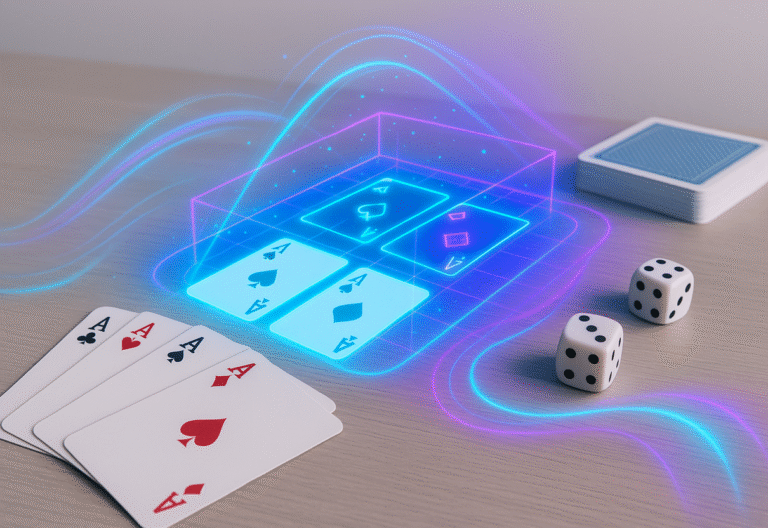Augmented reality is revolutionizing how you interact with table games. With dynamic visuals and interactive features, AR creates an engaging atmosphere that captivates players. Discover how Spinbara offers a platform for exploring these immersive experiences. For more details on this evolution, visit https://spinbara.com/nz/.
The integration of augmented reality (AR) into table games marks a significant shift in the gaming industry. AR technology overlays digital elements onto the real world, transforming traditional games into immersive experiences. This innovation offers players a new level of interaction, enhancing both enjoyment and engagement. As gaming technology evolves, platforms like Spinbara provide enthusiasts with insights into these developments.
Introduction to AR in Table Games
AR technology is reshaping the landscape of table games by introducing a blend of virtual and physical elements. This fusion allows you to experience classic games in a modern context, enriching gameplay with interactive features. Imagine playing poker where the cards come alive with vibrant animations or rolling dice that reveal additional data overlays.
The transformation of these traditional games is not merely about aesthetics; it’s about creating an environment where players can engage more deeply with the content. AR enables a more personalized gaming experience, where your interactions are seamlessly integrated into the game’s fabric. Such advancements are widely discussed, highlighting user enthusiasm for this technological leap.
This shift towards AR-fueled table games reflects a broader trend within the gaming industry. The demand for more interactive and visually stimulating content drives developers to incorporate these technologies into their designs. With AR at its forefront, the future of table gaming looks promisingly immersive and dynamic.
Engaging User Experiences
One of the most compelling aspects of AR in table games is the enhanced level of engagement it fosters. These games are no longer static; they are lively and responsive to your actions, making every move feel significant. Spinbara showcases how users are drawn to these immersive experiences, reporting increased satisfaction and prolonged gameplay sessions.
The interactive nature of AR-fueled games offers players a sense of presence that traditional formats lack. By blending digital enhancements with physical gameplay elements, players find themselves part of an evolving narrative that reacts to their decisions in real-time. This engagement is critical in retaining interest and promoting a deeper connection between the player and the game.
Such interactions go beyond mere entertainment—they represent a shift towards more meaningful player involvement. The feedback gathered underscores the growing appreciation for these rich, engaging experiences that redefine what it means to play a table game in today’s tech-savvy world.
Innovative Game Design
The design of AR-based table games is undergoing a transformation as developers explore new ways to captivate audiences. Various approaches are highlighted by designers who integrate AR elements to create compelling game environments that challenge traditional norms.
Incorporating augmented reality allows developers to experiment with novel mechanics and visual styles that enhance storytelling and gameplay depth. Games now feature intricate designs where each element contributes to an overarching immersive experience tailored to individual preferences.
This approach to game design also opens up possibilities for customization, enabling you to tailor your gaming environment according to personal tastes or strategic needs. This customization is key to attracting diverse audiences eager for unique, personalized gaming encounters.
User Feedback and Engagement
Feedback from users on platforms like Spinbara reveals much about the impact of AR on player engagement in table games. Enthusiasts praise the heightened sensory involvement and interactive dynamics provided by augmented reality technology. Such discussions underscore how AR is changing user expectations regarding interactivity and immersion.
As players become more accustomed to these advanced features, their expectations continue to evolve, pushing developers to innovate further. Users frequently share their experiences online, offering valuable insights into what resonates with them most—be it stunning visuals or intuitive interfaces that respond fluidly to input.
This feedback loop is crucial for refining game designs that meet the demands of modern players seeking ever-more engaging experiences. By continuously evolving based on community input shared through various sites, developers can ensure their offerings remain relevant and exciting amid rapidly changing technological landscapes.
Future Trends and Expectations
The future of augmented reality in table games holds exciting prospects for both casual gamers and dedicated enthusiasts alike. Emerging trends suggest even greater integration of AI-driven elements alongside AR technologies to create smarter, more adaptive gaming environments.
Developers are exploring possibilities such as real-time data analysis within games or adaptive AI opponents who learn from your play style over time—offering tailored challenges that evolve alongside you as you progress through different levels or scenarios.
Looking ahead at potential advancements in hardware capabilities combined with software innovations will likely lead us towards increasingly sophisticated iterations where virtual worlds blend seamlessly with our own physical surroundings—creating unparalleled levels of immersion previously thought unattainable within tabletop formats alone.

